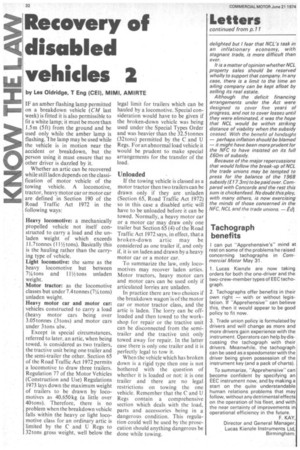Recovery of disabled vehicles 2
Page 34

If you've noticed an error in this article please click here to report it so we can fix it.
by Les Oh:fridge, T Eng (CEO, MIMI, AMIRTE IF an amber flashing lamp permitted on a breakdown vehicle (CM last week) is fitted it is also permissible to fit a white lamp; it must be more than 1.5 m (5ft) from the ground and be used only while the amber lamp is flashing. 1 he lamp may be used while the vehicle is in motion near the accident or breakdown, but the person using it must ensure that no other driver is dazzled by it.
Whether an artic can be recovered while still laden depends on the classification of motor vehicle of the towing vehicle. A locomotive, tractor, heavy motor car or motor car are defined in Section 190 of the Road Traffic Act 1972 in the following ways:
Heavy locomotive: a mechanically propelled vehicle not itself constructed to carry a load and the unladen weight of which exceeds 11.7 tonnes (111/2 tons). Basically this is the hauling rather than the carrying type of vehicle.
Light locomotive: the same as the heavy locomotive but between
71/4 tons and 111/4tons unladen weight.
Motor tractor: as the locomotive classes but under 7.4 tonnes (71/4 tons) unladen weight.
Heavy motor car and motor car: vehicles constructed to carry a load (heavy motor cars being over 3.05 tonnes (3 tons) and motor cars under 3 tons ulw.
Except in special circumstances, referred to later, an artic, when being towed, is considered as two trailers, the tractive unit being one trailer and the semi-trailer the other. Section 65 of the Road Traffic Act 1972 permits a locomotive to draw three trailers. Regulation 77 of the Motor Vehicles (Construction and Use) Regulations 1973 lays down the maximum weight of trailers to be drawn by locomotives as 40,650 kg (a little over 40 tons). Therefore, there is no problem when the breakdown vehicle falls within the heavy or light locomotive class for an ordinary artic is limited by the C and U Regs to 32 tons gross weight, well below the legal limit for trailers which can be hauled by a locomotive. Special consideration would have to be given if the broken-down vehicle was being used under the Special Types Order and was heavier than the 32.5 tonnes (32 tons) permitted by the C and U Regs. For an abnormal load vehicle it would be prudent to make special arrangements for the transfer of the load.
Unloaded If the towing vehicle is classed as a motor tractor then two trailers can be drawn only if they are unladen (Section 65, Road Traffic Act 1972) so in this case a disabled artic will have to be unloaded before it can be towed. Normally, a heavy motor car or a motor car may draw only one trailer but Section 65(4) of the Road Traffic Act 1972 says, in effect, that a broken-down artic may be considered as one trailer if, and only if, it is un laden and drawn by a heavy motor car or a motor car.
To summarize the law, only locomotives may recover laden artics. Motor tractors, heavy motor cars and motor cars can be used only if articulated lorries are unladen.
In practice there are two choices if the breakdown wagon-is of the motor car or motor tractor class, and the artic is laden. The lorry can be offloaded and then towed to the workshop for repair or the tractive unit can be disconnected from the semitrailer and the tractive unit only towed away for repair. In the latter case there is only one trailer and it is perfectly legal to tow it.
When the vehicle which has broken down is a rigid type then one is not bothered with the question of whether it is loaded or not: it is one trailer and there are no legal restrictions on towing the one vehicle. Remember that the C and U Regs contain a comprehensive section which deals with the load, parts and accessories being in a dangerous condition. This regulation could well be used by the prosecution should anything dangerous be done while towing.








































































































